Texas Tree Tips: January 2015
by Steve Houser
Fruit Tree Pruning
In general, fruit-bearing trees are not all built the same, and the type of pruning required depends on the intended outcome and the species of tree. A fruit tree planted in a yard for its aesthetic qualities requires a different pruning method than that used by an orchard grower who wants to produce a maximum amount of fruit that is simple and easy to pick. Many fruit tree species do not naturally grow in a way that produces a bumper crop. Proper pruning helps to produce more fruit that fully matures and has better color as well as taste. Much of the information on the Internet can be conflicting and confusing, so develop a clear objective before you pick up your handsaw and pruners.
Basic Pruning Theory
The tip ends of limbs, or terminal buds, on any tree will enjoy more rapid growth than the buds growing off the sides of the limbs before reaching the tip end. That’s because the terminal bud (or buds) suppresses the growth of the other, lateral buds, a phenomenon referred to as “apical dominance.” The apical dominance is altered when the terminal buds are removed, allowing the lateral buds to become more vigorous and dominant on some species. This forces the tree to produce more fruit on the interior of the tree rather than on the ends of long limbs. Such terminal bud removal also reduces the potential for limb breakage due to excessive end weight. Annual pruning by an orchard grower also helps to maintain the size of the tree and encourages sunlight and air penetration to the inside of the tree. This helps to reduce the influence of various pathogens and produces healthier fruit. Even with proper pruning, however, professional growers must apply various materials during the year to manage problematic insects and bacterial/fungal pathogens that can spoil the fruit. Pruning to increase fruit production does not automatically ensure a shining harvest moon!
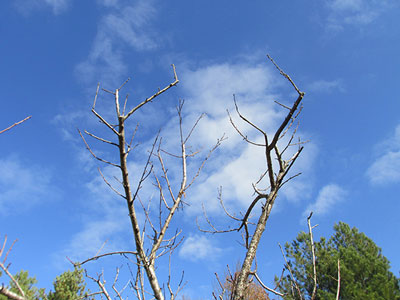
Peach trees are included in the group of fruit trees that require more severe pruning than most. All photos courtesy of Arborilogical Services.
Basic Pruning Guidelines
A property owner who is interested primarily in the aesthetics of the tree rather than high fruit production will only need to remove dead limbs, provide some branch separation where limbs rub or cross, and perform some minor thinning of foliage and limbs, much the same as pruning a typical shade or ornamental tree. All cuts should be made at the proper angle. See this earlier e-gardens article. And the homeowner should avoid over-pruning. As a fruit tree pruned only for aesthetics ages, there is often a need to reduce the weight on the ends of longer limbs because the fruit is produced primarily on the ends, increasing the potential for breakage.
The theory of fruit tree pruning for production does not apply equally to all species. Here is how the species are separated:
- Group A includes cherries, jujube, persimmon, pomegranate, and European plums, which require the least amount of pruning and do not respond well to topping or heading back lateral limbs. These don`t require much pruning beyond deadwood removal and cuts to encourage a strong structure. These species don`t set strong fruit “spurs” (short fruit-bearing projections).
- Group B includes apples and pears, which should be kept short in height with tips headed back to lateral limbs to encourage strong fruit spurs.
- Group C includes peaches, Japanese plums, apricots, and nectarines, which are pruned back more severely than the any other fruit trees, yet don`t develop strong fruit spurs as well as group B.
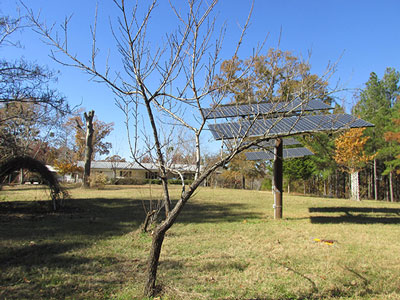
This peach tree has developed with little or no pruning and will not bear well without help.

For better fruit bearing, the tree has had branch tips removed to create stronger scaffolding.
Only group A is pruned the same as a shade or ornamental tree. These species should never be pruned the same as groups B and C.
There are a number of different methods utilized for fruit tree pruning that produce various results. Those varying methods can be confusing to the typical property owner. It is important to first understand the types of cuts that can be made, as well as their effect on the tree:
- A topping cut removes a large limb that’s more than 2 to 3 inches in diameter in the outer portions of a tree, leaving just a stump or a very small lateral limb. Topping removes a large amount of foliage, which is rough on tree health and encourages more leafy growth than fruit. Severe foliage removal should be avoided on all types of trees.
- A heading cut removes the end of a smaller limb that is less than 2 to 3 inches in diameter, cutting back to a slightly angled stump or lateral limb of similar size. This cut increases the amount of fruit produced (if it is done correctly) and forces fruit to grow on lateral stems (known as fruit spurs) inside the canopy. Cuts are made at a slight angle and preferably, at the juncture of another bud or limb. Fruit spurs have a life expectancy of one to 10 years, depending on the species, and heading cuts can encourage a new set of fruit spurs.

Any fruit that forms on these long branch tips would be limited and perhaps cause breakage.

Now headed back, these limbs are ready for improved fruit production on lateral branches.
- A thinning cut removes an entire shoot or stem to the point of its origin. The purpose of the cut is to thin areas of dense foliage or limbs to allow more sunlight and air to reach interior fruit as well as leaves. This cut is used to produce healthy fruit but has less effect on the amount of fruit produced than other types of cuts.
- A drop-crotch cut is typically used on an old tree that is producing little fruit or fruits only on the ends and not inside the canopy. The outer growth of the tree is selectively cut back to a lateral limb (or side growth) that is at least a third to half the diameter of the parent stem. However, limbs should not be cut back (or drop-crotched) to limbs larger than 3 to 4 inches in diameter. This cut is used to reduce the weight of longer limbs that were not pruned previously or not properly pruned. These cuts on older trees may slow the production of fruit and they can have a negative effect on the tree’s health for a few years, but they reduce the potential for limb breakage.
- A bench cut is basically cutting back exterior limbs to the exact same point each year. This produces a large number of sprouts (often called watersprouts or suckers) and increases foliage on the exterior of the tree, which reduces the amount of fruit produced on the inside as well as reducing its quality (looks and taste). Avoid this type of cut and pruning method because it encourages more foliage rather than fruit, and it increases the potential for sunscald or sun damage due to excessive sunlight on the interior limbs. Too much shade equals no fruit on the inside, and too much sun equals sunscald damage to limbs or trunks. If you like a tree that looks like Medusa, this is the cut for you!!
Never remove more than 20 to 30 percent of a tree’s foliage in any given year. It is better to train your tree a little each year rather than try to catch up after missing a few years. Make cuts early and often. Proper pruning for established trees involves removing dead limbs, as well as those that may rub or cross each other, correcting weak branch structures, and thinning areas of dense foliage or limbs, in much the same way we prune shade and ornamental trees. This includes trees in groups A, B, and C.
Recently planted trees in group B and C should have heading cuts on the tips, made at a slight angle rather than flat. By heading back the center, energy is diverted to scaffold or lateral buds, which typically grow at a 90 degree angle off the parent stem. The ideal angle for all limbs that branch off a stem or trunk is between 45 and 60 degrees in an upright position, since any downward growth can reduce apical dominance and fruit production. An angle of less than 30 degrees or a tight V-shaped fork will have increased tendency to break under the weight of a heavy fruit crop and requires removal of the less dominant stem.
Pears, apples and sometimes apricots will produce a bumper crop, but the fruit cannot reach maturity and may not produce next year without thinning the fruit. Fruit thinning is done by hand or with a pruning knife and is most effective when done in the early summer. The amount of fruit to remove varies according to the species of tree, its size, and the amount of crop currently produced.
Pruning methods
- The open center method is used on many species and requires removing or cutting back vigorous upright limbs in the center to increase sunlight in this area, as well as to increase air movement. Species include groups B and C, as well as plums and pistachios. Scaffold limbs should be at least several inches apart and separated along the stem rather than congregated close to each other.
- The central leader method leaves one or several dominant or vigorous central leaders with layers of lower limbs that can create a triangle shape. The species include group B, cherries, and persimmons. The triangle growth form allows filtered sunlight on all sides and through the center. There is also a modified central leader method that begins the same as noted above, but as the lateral limbs develop for a few years, a portion of the top is removed to encourage more fruit lower on the tree.
- The bush method is sometimes used for dwarf fruit species and trees in groups B and C. Trees are kept small by cutting back all the top growth at least twice a year. As with the bench cut, trees should not be cut back to the same place each year. Alter the height of top growth rather than giving it a flat top haircut if you choose this method. Some authorities suggest this method, but it is hard on the health of the tree and it has a negative effect on longevity. Most dwarf species only need thinning or deadwood removal in the dormant season as they age.
- Standard method tree pruning involves the basic care of a tree as previously noted for those primarily interested in the aesthetics of the tree. This method is used for many citrus fruits, figs, jujubes, almonds, and pomegranates. As figs mature, cutting back the tips to lateral buds or spurs can encourage better fruit.
First year
During the dormant season after the first year, some of the top is often thinned or removed entirely to allow interior sunlight and air circulation for groups B and C. Dormant-season pruning is typically done in January or early February, depending on the weather. Upright and tall vertical limbs are often headed back to strong lateral growth but not removed. Determine which limbs will serve as the primary scaffold limbs in the future. Go easy on pruning in the first few years because you can delay fruit production, especially if the pruning is excessive. Orchard growers often use clothespins, wooden dowels or padded wires between limbs to force the tree to form the best angles of attachment to support the future weight.
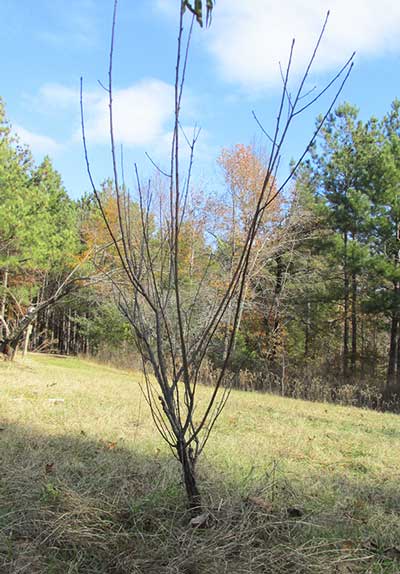
This young peach needs to be encouraged with judicious pruning.
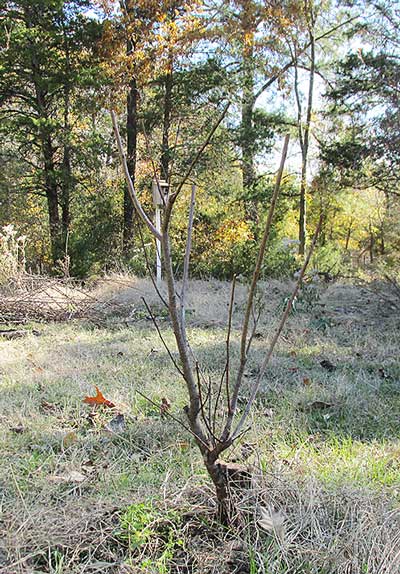
Now headed in the right direction, the young peach can grow into a sturdy producer of fruit.
Second year
During the second year, limit summer pruning (typically done in June for many species) to dead limbs or excessive water sprouts on all three groups. Excessive summer pruning before harvest should be avoided, as it can delay the maturity of the fruit and reduce the quality of the fruit as well as its size. Limit pruning primarily to the dormant season. Use thinning and heading cuts (for groups B and C) and avoid severe bench cuts. Weak limb structures should be removed anytime they start to appear; a strong branching habit is an important aspect of proper pruning for all tree species. Sprouts growing from the base of the trunk or roots should be removed as they appear on all trees.
Older trees
With older fruit trees in groups B and C, the fruit tends to bear more on the exterior of the tree rather than in the center as desired for production. Once this occurs, it is difficult to change back to higher fruit production inside the tree, so heading as well as drop-crotch cuts are often required. This can invigorate the tree but cause a temporary drop in production. Additionally, reduce or remove vigorous interior sprouts and thin to reduce foliage density, if required.
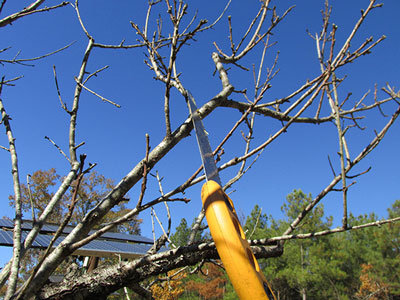
Heading back larger branches will require a fine-toothed handsaw.
General topics
Never prune when a tree is lacking water or during a drought, as it can have a negative effect on growth. Also, as noted previously, the newer varieties of dwarf fruit trees should not need pruning other than deadwood removal and encouraging strong structure. Prune no more than you must or the tree may not produce fruit at all.
Use a bypass hand pruner for smaller cuts under an inch. The term “bypass” refers to the sharp blade that passes by the stationary blade and leaves a sharp cut, cleanly sheared. Cuts over an inch require a fine-toothed handsaw to avoid tearing the cut. Avoid the “anvil” style of pruners where the sharp blade is squeezed against a flat anvil. These pruners tend to pinch the wood fibers rather than cleanly cutting them.
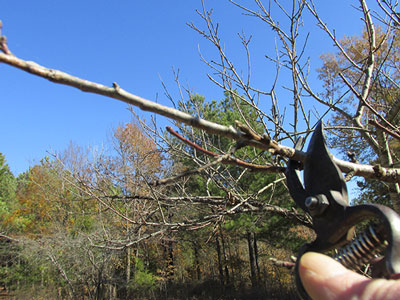
Bypass pruners are used here for an all-important heading cut, back to a lateral limb.
There are a considerable number of pathogens that can affect fruit trees, and some management can be achieved with proper pruning to offset the problem (scab, cedar apple rust, bacterial cankers, sooty blotch, mildew, fire blight, among many others). Allowing maximum sunlight and airflow to most all of the foliage tends to reduce the spread and effect of these pathogens. Fire blight can cause the loss of apples as well as pears, so resistant varieties should be selected. Control involves removing sections of limbs 6 to 8 inches back from infected areas and sterilizing tools after each cut. Ten percent bleach with water will work, but you must oil your tools afterward or they will rust. Alcohols that are 190-proof also work, but seem to be a waste of good resources.
If your fruit tree is not producing, it may not be your pruning. Fruit trees often lack a pollinator tree of the correct species in the vicinity, or they may lack bees to assist with pollination. For example, a Japanese plum will not pollinate a European plum. If you are not sure, check with Texas AgriLife Extension Service or a Texas Master Gardener in your area.
EDITOR’S NOTE: Steve Houser’s series on Tree Planting continues next month, with an article on “Follow-Up Care for Newly Planted Trees.”

